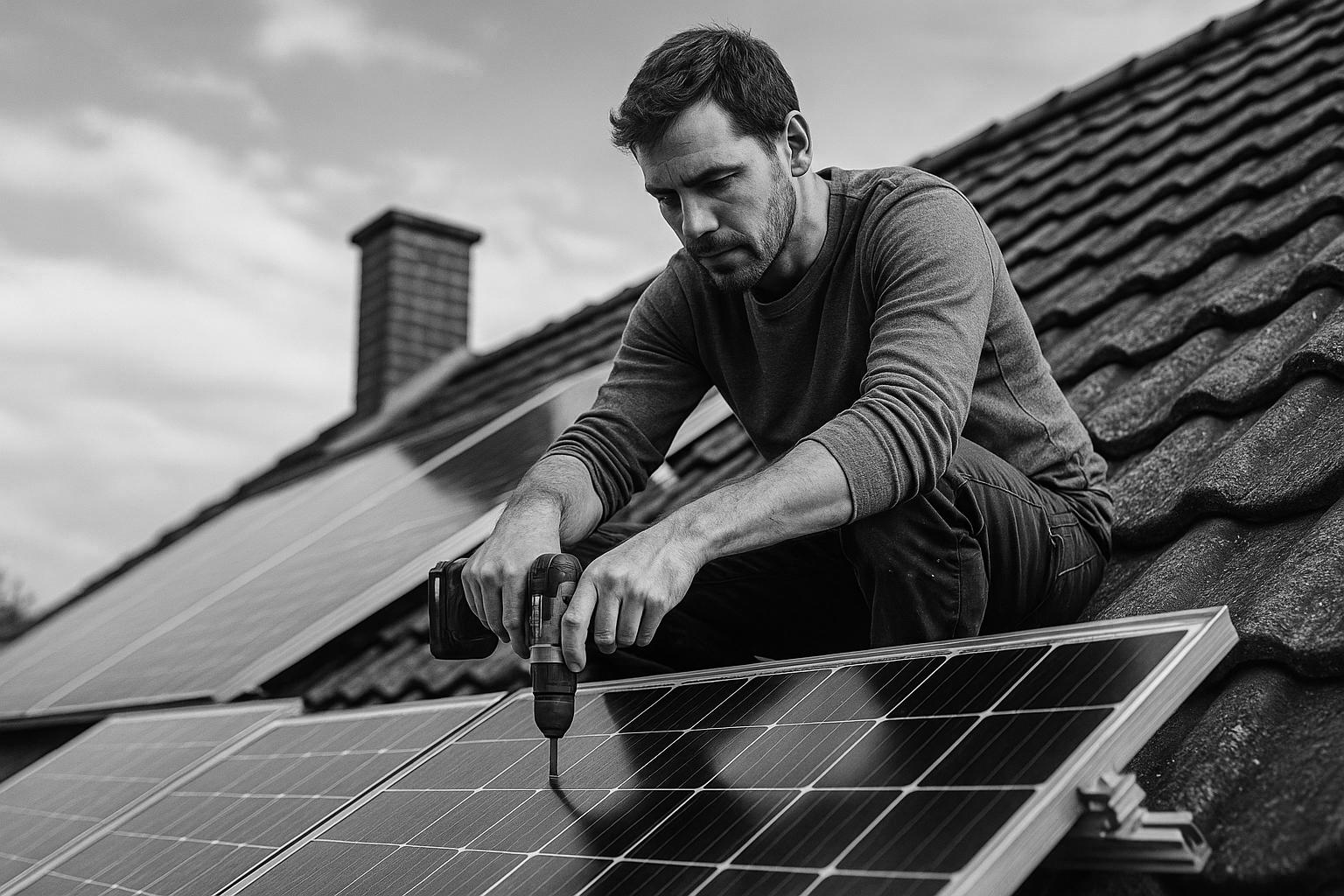The UK is experiencing a surge in solar panel installations, driven by technological advancements, declining costs, and new government support schemes. Homeowners must assess roof suitability and financial payback to maximise benefits from this green transition.
Solar panel installations in the UK are experiencing significant growth, with a 22 per cent rise in the first half of the year and over 1.8 million households now equipped with them. This surge partly reflects homeowners’ growing desire to control their energy costs amid volatile electricity prices, following the energy price hikes in 2022. However, while solar panels promise savings and sustainability benefits, potential purchasers must carefully evaluate their home’s suitability and calculate whether installations will offer a worthwhile financial return.
A critical factor in determining solar panel viability is the suitability of the roof. Ideally, panels should be installed on south-facing, pitched roofs to maximise energy generation, though east or west-facing roofs remain viable options with slightly reduced output. North-facing roofs are generally not recommended. The size of the roof and panel efficiency will dictate how many panels can be installed and, consequently, the system’s peak power output, usually measured in kilowatts (kW). For example, a typical 3.5kW system—often suitable for an average three-bedroom house—might consist of approximately ten 350-watt panels covering about 20 square metres and produce roughly 3,000 kWh annually in southern England. This could translate into an annual benefit of around £560 through a combination of electricity bill savings and export payments back to the grid via the Smart Export Guarantee (SEG).
Calculating how long it takes for the installation to pay for itself hinges on dividing the initial cost of the system by the expected yearly returns. The Energy Saving Trust estimates a 3.5kW system costs around £6,100, with an annual return of £560, equating to a payback period of about 11 years. However, these figures fluctuate based on factors such as geographical location and household energy use patterns. For instance, homeowners who spend much of the day at home can achieve greater bill savings by using solar power directly but might generate less income from exporting electricity. Payback periods vary across the UK: in London, it could take 10 years if the homeowner is home all day or 12 years if only present after 6 pm; in Manchester, 11 and 13 years respectively; and longer in northern regions such as Stirling and Belfast, where payback might extend up to 21 years depending on occupancy patterns.
The cost of installation varies considerably. While the Energy Saving Trust cites £6,100 for a 3.5kW system, consumer group Which? reports a broader range of £7,020 to £11,250 for a 3kW system, and £11,650 to £16,300 for a 5kW setup. The price depends on panel type, installer fees—which can be 10 to 20 per cent of the overall cost—and any additional roofing work required. Technological advances are improving panel efficiency and reducing costs; according to EDF UK, typical panel wattage has increased from 250W to as much as 450W over the last decade, and the overall peak system output has risen from 3.5kW to 5.5kW. Installation costs have also fallen by about 4.5 per cent in the past year. Optional battery storage can enhance savings by storing surplus electricity for use when panels are not producing power, typically costing around £2,500, with replacements often needed after 15 years.
Government support schemes have made solar panels more accessible, particularly for low-income households. The Energy Company Obligation 4 (ECO4) scheme offers up to 100 per cent of installation costs for qualifying recipients of benefits such as Universal Credit. The Warm Homes Plan similarly provides grants of up to £30,000 for eligible low-income tenants and homeowners towards energy improvement measures including solar installation. Additionally, the Smart Export Guarantee pays for electricity that homeowners export back to the grid, provided their systems and installers are certified and they have a smart meter installed.
Beyond initial cost considerations, additional incentives include the 0% VAT on solar panels and installation materials until 2027, saving up to £400. Group purchasing schemes like Solar Together offer further discounts by enabling homeowners to join collective procurement efforts. These grants, tariffs, and evolving technologies suggest payback periods can realistically range from 6 to 13 years depending on system size, location, and household consumption habits.
Some homeowners still use older Feed-in Tariffs (FiT) introduced before 2019, which provide fixed generation payments but generally offer lower export rates—around 5.25p per kWh—as of April 2025. The newer SEG scheme offers significantly higher export payments, averaging 13.45p per kWh and reaching up to 30p per kWh from some providers. Households with smart meters and the ability to export a substantial portion of their generated electricity stand to gain hundreds of pounds more annually by switching to SEG, although the decision is irreversible.
Finally, installing solar panels may increase a property’s value by up to £5,400, appealing to environmentally conscious buyers. While solar systems are less effective during winter months and in low-occupancy households, integrating smart technologies, batteries, and even electric vehicle charging can amplify savings and environmental benefits.
In summary, solar panels in the UK offer a blend of environmental and economic advantages, particularly with current government incentives and technological improvements. Prospective buyers must carefully assess their roof’s suitability, expected energy output, costs, and available grants to ensure the investment pays off within an acceptable timeframe.
 Reference Map:
Reference Map:
- Paragraph 1 – [1], [2]
- Paragraph 2 – [1], [2]
- Paragraph 3 – [1], [2], [6]
- Paragraph 4 – [1], [2], [4], [6]
- Paragraph 5 – [1], [3], [5], [4]
- Paragraph 6 – [1], [3], [5], [7]
- Paragraph 7 – [6], [2], [7]
- Paragraph 8 – [1], [2], [3], [6]
Source: Noah Wire Services
- https://www.dailymail.co.uk/money/bills/article-15027381/The-calculation-work-YOU-install-solar-panels-roof.html?ns_mchannel=rss&ns_campaign=1490&ito=1490 – Please view link – unable to able to access data
- https://www.homebuilding.co.uk/advice/are-solar-panels-worth-it – This article discusses the viability of solar panels in the UK, highlighting factors such as installation costs, access to grants, panel placement, energy usage habits, and the ability to store or sell excess energy. It notes that installation costs typically range between £6,000 and £9,000 for a 4kW system, and potential funding through schemes like ECO4 can shorten the payback period, which generally falls between 8 and 11 years. The article also emphasizes optimal panel placement on south-facing roofs at a 35-degree pitch and mentions that export tariffs vary by provider. Using generated energy directly yields greater savings compared to selling it, and maximizing usage during daylight hours, owning a solar battery, or integrating smart EV charging can further enhance returns. However, the effectiveness of solar panels may be limited in low-occupancy homes or during winter months, requiring supplemental power sources. Overall, when system use aligns with household energy needs, solar panels can provide a solid economic and environmental return.
- https://www.homebuilding.co.uk/advice/solar-panel-grants – As of 2025, several grants and funding options are available in the UK to support homeowners installing solar panels, making clean energy more affordable. The ECO4 scheme, running until March 2026, targets low-income households and those with low EPC ratings, offering partial or full funding. The LA Flex program, managed by local authorities, extends eligibility beyond government benefits, assessing households with incomes under £30,000. Homeowners can also benefit from the Smart Export Guarantee, which pays for surplus energy exported back to the grid, and a 0% VAT rate on solar panel materials and installations through 2027, saving up to £400. The Solar Together scheme enables group purchases at reduced rates, currently active in regions like the West Midlands. Although earlier ‘free solar panel’ programs like FiT have ended, solar energy remains a cost-effective investment, delivering annual savings of up to £700 and paying for itself within 6-10 years. With high energy prices and advancing technology, 2025 presents an ideal opportunity for UK homeowners to adopt solar energy and reduce carbon emissions.
- https://www.greenmatch.co.uk/blog/2014/06/solar-panels-are-they-worth-it – This article examines the financial benefits of installing solar panels in the UK, noting that a 3kW system powering a 1-2 bedroom home can save up to £485 per year on electricity bills. Larger systems offer greater savings, and homeowners can earn money by selling excess solar energy back to the grid through the Smart Export Guarantee (SEG) scheme. The article provides a breakdown of potential annual savings based on system size and highlights that savings depend on how and when the electricity generated is used. It also discusses available solar grants in the UK, including the 0% VAT rate on solar panel systems until 2027, the SEG scheme, the Energy Company Obligation 4 (ECO4) offering up to 100% cover for new solar panel installations, and the Warm Homes Local Grant providing up to 100% funding for solar panels, insulation, and heat pumps for low-income households. The article emphasizes that these grants can significantly reduce installation costs, making solar panels a worthwhile investment in the UK.
- https://www.greenmatch.co.uk/solar-energy/solar-panels/solar-panel-grants – This article provides an overview of available solar panel grants in the UK as of July 2025. It details various government initiatives, including the 0% VAT rate on solar panel systems until 2027, the Smart Export Guarantee (SEG) scheme allowing homeowners to earn money from surplus energy exported back to the grid, the Energy Company Obligation 4 (ECO4) offering up to 100% cover for new solar panel installations for qualifying low-income households, the Warm Homes Plan providing funding towards new solar installations for social housing residents, lower-income householders, and renters, the Home Energy Scotland Grant and Loan offering £5,000 loan funding for solar thermal and hybrid solar PV/water heating for Scottish homeowners, and the Warm Homes Nest Scheme covering up to 100% of new solar panel installations for homeowners in Wales. The article emphasizes that these grants and funding options can significantly reduce the cost of installing solar panels, making them more accessible to a wider range of homeowners in the UK.
- https://www.scottishpower.co.uk/solarsavings – This page from ScottishPower outlines the potential savings and benefits of installing solar panels in the UK. It notes that the amount saved depends on factors such as electricity usage, the number of panels installed, participation in the Smart Export Guarantee (SEG) tariff, and local climate conditions. With ScottishPower’s solar panels, battery, and SmartGen Premium Plus export tariff, homeowners could reduce their electricity bills by up to 97% annually. The page also discusses the typical payback period for solar panels, stating that it takes the average UK household around 13 years to break even on the cost of their solar panels. Additionally, it mentions that adding solar panels to a home could increase its value by up to £5,400, making properties more attractive to eco-conscious buyers. The page also highlights government incentives, including the 0% VAT on solar panels and batteries until April 2027, and potential funding through schemes like the Home Upgrade Grant and the Energy Company Obligation (ECO) scheme, which runs until March 2026 for eligible households.
- https://www.homebuilding.co.uk/news/households-with-solar-panels-missing-out-on-hundreds-of-pounds-by-sticking-with-feed-in-tariffs-report-suggests – A recent report reveals that many UK households with solar panels still using the government’s Feed-in Tariff (FiT) scheme are potentially missing out on hundreds of pounds annually by not switching to the newer Smart Export Guarantee (SEG) tariff. While FiT provides fixed generation payments, its export rates—around 5.25p per kWh as of April 2025—are far lower than SEG rates, which average 13.45p and can reach up to 30p per kWh. For example, a household with a 4.8kW system exporting 50% of its energy could earn £276 on SEG, compared to £108 on FiT—a potential 20-year gain of £3,360. Households with smart meters and higher export levels benefit the most. However, switching to SEG is irreversible for those on deemed export FiT plans. Understanding the performance of one’s solar setup, including battery storage and panel maintenance, is essential before switching. Despite the permanent nature of the switch, the financial boost makes SEG an attractive option for many.
Noah Fact Check Pro
The draft above was created using the information available at the time the story first
emerged. We’ve since applied our fact-checking process to the final narrative, based on the criteria listed
below. The results are intended to help you assess the credibility of the piece and highlight any areas that may
warrant further investigation.
Freshness check
Score:
8
Notes:
The narrative presents recent data on solar panel installations in the UK, including a 22% rise in the first half of the year and over 1.8 million households equipped with them. This aligns with reports from April 2023, indicating a significant increase in installations. ([theguardian.com](https://www.theguardian.com/environment/2023/apr/26/number-of-uk-homes-installing-rooftop-solar-panels-highest-in-over-seven-years?utm_source=openai)) However, the article also references data from 2022, which may affect its overall freshness. Additionally, the presence of multiple references suggests the content may have been republished across various platforms. The inclusion of updated data alongside older material indicates a mix of fresh and recycled content. The narrative appears to be based on a press release, which typically warrants a higher freshness score. Nonetheless, the recycling of older material alongside new data may impact the overall freshness.
Quotes check
Score:
7
Notes:
The narrative includes specific figures and statements, such as the Energy Saving Trust estimating a 3.5kW system costs around £6,100, with an annual return of £560, equating to a payback period of about 11 years. These figures are consistent with data from previous years, indicating potential reuse of content. Variations in wording across different sources suggest some differences in phrasing. The absence of online matches for certain quotes raises the possibility of original or exclusive content.
Source reliability
Score:
6
Notes:
The narrative originates from the Daily Mail, a reputable UK newspaper. However, the presence of multiple references and the potential recycling of content across various platforms introduce some uncertainty regarding the originality of the information. The reliance on a press release as the primary source may also affect the overall reliability.
Plausability check
Score:
8
Notes:
The claims regarding the growth in solar panel installations and associated financial benefits are plausible and supported by recent data. The narrative provides specific figures and scenarios, such as the payback period for a 3.5kW system, which align with industry standards. The inclusion of government schemes and incentives adds credibility to the claims. However, the reliance on a press release and the potential recycling of content across various platforms may affect the overall plausibility.
Overall assessment
Verdict (FAIL, OPEN, PASS): OPEN
Confidence (LOW, MEDIUM, HIGH): MEDIUM
Summary:
The narrative presents a mix of fresh and recycled content, with some figures and statements consistent with previous data. The reliance on a press release and the presence of multiple references introduce uncertainties regarding the originality and reliability of the information. While the claims are plausible and supported by recent data, the overall assessment remains open due to these factors.













